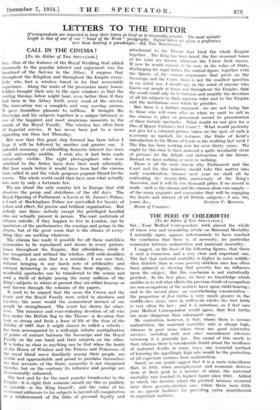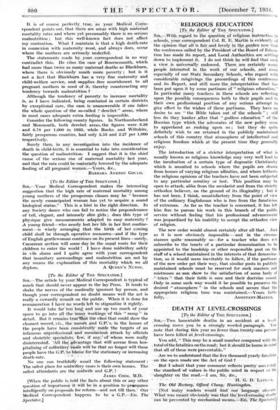THE PERIL OF CHILDBIRTH
[To the Editor of TilE SPECTATOR.] Sin,—YOur Medical Correspondent, with almost the whole of whose wise and stinmlating article on Maternal Mortality I naturally agree, appears unfortunately to 'have reached the conclusion that there is, of necessity, no particular connexion between malnutrition and maternal mortality.
I suggest, on the basis of the following figures, that there is such a connexion, and a very clear and important one. The fact that maternal mortality is higher in some middle- elits districts than in some poverty-stricken ones has often been adduced as showing that poverty has . no influence upon the subject. But this conclusion is not statistically justified. In the first place, we have no knowledge which enables us to tell what effects the previous kinds of occupation (or non-occupation) of the mothers have upon child-bearing ; and in the second place--- an overwhelming consideration— the proportion of first births is very much greater in the middle-class areas, since in well-to-do circles the first birth is very often the last ; and it is notorious, as I feel sure your Medical Correspondent would agree, that first births are more dangerous than subsequent ones.
My contention, however, is that, where there is serious malnutrition, the maternal mortality rate is always high, whereas in poor areas where there arc good maternity services, including milk and other nourishment wherever _necessary, it is generally low. The moral of this surely is that, whereas there is considerable doubt about the incidence Of maternal deaths in many ways, one essential method of lowering tlw appallingly high rate would be the protection Of all expectant mothers from malnutrition. Surely no one would suggest that it is a mere coincidence that, in 1933, when unemployment and economic. distress were at their peak in a number of areas, the maternal • mortality rate touched its highest figure since 1911. Added to which, the districts where the greatest increase occurred were those poverty-stricken ones where there were little or no special facilities for providint extra nourishment to expectant mothers. It is of course perfectly true, as your Medical Corre- spondent points out, that there are areas with high maternal mortality rates and where yet presumably there is no serious malnutrition ; but this well-known fact does not affect my contention. What I, maintain is that a high death-rate in connexion with maternity must,_ and always does, occur where the mothers are seriously underfed- . The statements. made. by. your, correspondent in no way contradict this. He cites the case of Bournemouth, which. had more than twice as many maternal deaths as Blackburn, where there is obviously much more poverty ; but is it not a fact that Blackburn has a very fine maternity and child-welfare service, - and supplies. ..free nourishment to all pregnant mothers in- need of .it, - thereby counteracting any
tendency towards malnutrition ? . • - Although the tendency of poverty to increase mortality is, as I have indicated, being combated -in certain districts. by exceptional care,: -the case is unanswerable if one takes the whole question: of the so-called !`-derelict-" areas, where in most cases adequate extra feeding is impossible. .
Consider the following-county figures. In Northumberland and Monmouth, both derelict areas, the figures were -.6.38 and 6.78 per -1;000:-in.• 1933, while Bucks. and Wiltshire, fairly prosperous counties, had only 2.53 and 2.27 per 1,000
. respectively. ' • ---
Surely then,. in any investigation into- the incidence- of death in child-birth, it is essential to take into consideration the question of -malnutrition, I suggest that- it is the chief cause of the serious rise of maternal mortality last year, and that the rate could be materially lowered by the adequate feeding of all pregnant wornen.—Yours, &c., • . BARBARA AYRTON GOULD.



















































 Previous page
Previous page